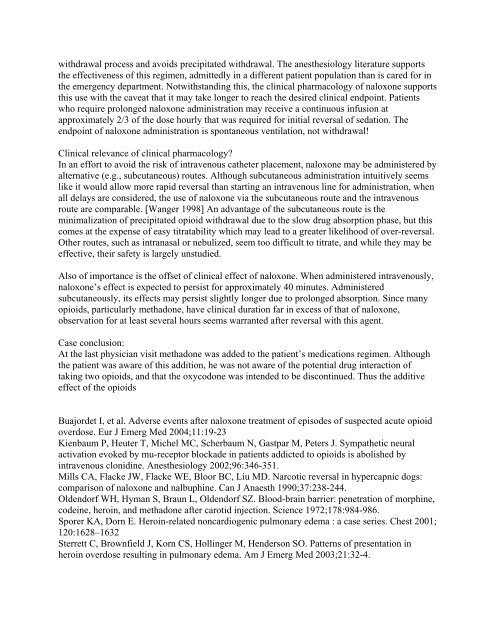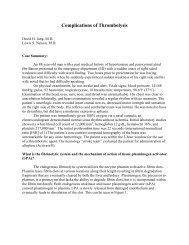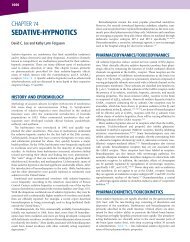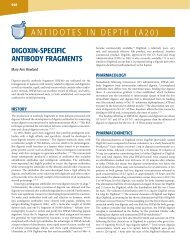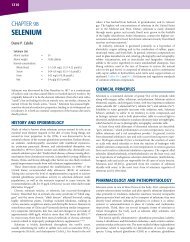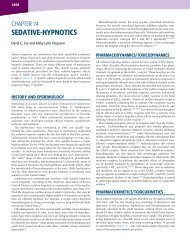Oxycodone and Naloxone
Oxycodone and Naloxone
Oxycodone and Naloxone
You also want an ePaper? Increase the reach of your titles
YUMPU automatically turns print PDFs into web optimized ePapers that Google loves.
withdrawal process <strong>and</strong> avoids precipitated withdrawal. The anesthesiology literature supportsthe effectiveness of this regimen, admittedly in a different patient population than is cared for inthe emergency department. Notwithst<strong>and</strong>ing this, the clinical pharmacology of naloxone supportsthis use with the caveat that it may take longer to reach the desired clinical endpoint. Patientswho require prolonged naloxone administration may receive a continuous infusion atapproximately 2/3 of the dose hourly that was required for initial reversal of sedation. Theendpoint of naloxone administration is spontaneous ventilation, not withdrawal!Clinical relevance of clinical pharmacology?In an effort to avoid the risk of intravenous catheter placement, naloxone may be administered byalternative (e.g., subcutaneous) routes. Although subcutaneous administration intuitively seemslike it would allow more rapid reversal than starting an intravenous line for administration, whenall delays are considered, the use of naloxone via the subcutaneous route <strong>and</strong> the intravenousroute are comparable. [Wanger 1998] An advantage of the subcutaneous route is theminimalization of precipitated opioid withdrawal due to the slow drug absorption phase, but thiscomes at the expense of easy titratability which may lead to a greater likelihood of over-reversal.Other routes, such as intranasal or nebulized, seem too difficult to titrate, <strong>and</strong> while they may beeffective, their safety is largely unstudied.Also of importance is the offset of clinical effect of naloxone. When administered intravenously,naloxone’s effect is expected to persist for approximately 40 minutes. Administeredsubcutaneously, its effects may persist slightly longer due to prolonged absorption. Since manyopioids, particularly methadone, have clinical duration far in excess of that of naloxone,observation for at least several hours seems warranted after reversal with this agent.Case conclusion:At the last physician visit methadone was added to the patient’s medications regimen. Althoughthe patient was aware of this addition, he was not aware of the potential drug interaction oftaking two opioids, <strong>and</strong> that the oxycodone was intended to be discontinued. Thus the additiveeffect of the opioidsBuajordet I, et al. Adverse events after naloxone treatment of episodes of suspected acute opioidoverdose. Eur J Emerg Med 2004;11:19-23Kienbaum P, Heuter T, Michel MC, Scherbaum N, Gastpar M, Peters J. Sympathetic neuralactivation evoked by mu-receptor blockade in patients addicted to opioids is abolished byintravenous clonidine. Anesthesiology 2002;96:346-351.Mills CA, Flacke JW, Flacke WE, Bloor BC, Liu MD. Narcotic reversal in hypercapnic dogs:comparison of naloxone <strong>and</strong> nalbuphine. Can J Anaesth 1990;37:238-244.Oldendorf WH, Hyman S, Braun L, Oldendorf SZ. Blood-brain barrier: penetration of morphine,codeine, heroin, <strong>and</strong> methadone after carotid injection. Science 1972;178:984-986.Sporer KA, Dorn E. Heroin-related noncardiogenic pulmonary edema : a case series. Chest 2001;120:1628–1632Sterrett C, Brownfield J, Korn CS, Hollinger M, Henderson SO. Patterns of presentation inheroin overdose resulting in pulmonary edema. Am J Emerg Med 2003;21:32-4.


